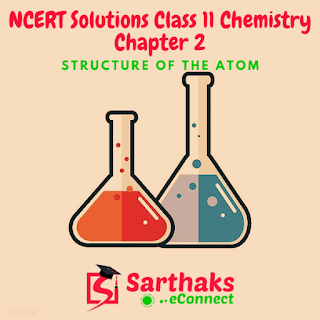NCERT Solutions Class 11 Chemistry Chapter 2 Structure of The Atom
NCERT Solutions for Class 11 Chemistry Chapter 2 Structure of The Atom is the most effective way to learn about it. Consult our NCERT Solutions to learn the fundamentals of this chapter and to prepare for CBSE term 1 board exams as well as competitive exams such as JEE Mains, JEE Advance, Olympiad, NTSE, and others. Subject matter experts created these NCERT Solutions to provide an in-depth analysis of all of the concepts covered here. This study guide is based on the most recent CBSE curriculum. We discussed all types of NCERT exercise questions as well as intext questions in this NCERT Solutions Class 11.
In NCERT Solutions Class 11 we have to study various important topics such as:
·
Atom Structure - An atom is the smallest
constituent particle of matter. A positive nucleus is surrounded by a cloud of
negatively charged particles to form an atom. Positively charged particles make
up the positive part of the atom. The proton and neutron are positively charged
atom particles, while the electron is negatively charged.
·
Subatomic Particles Discovered - It was
previously thought that an atom could not be further divided into smaller
particles. However, in an experiment conducted by scientists in the nineteenth
and early twentieth centuries, it was discovered that atoms are made up of
smaller particles known as subatomic particles. An atom's three subatomic
particles are:
o Neutron –
which has no charge
o Electrons
– which are negatively charged
o Proton –
which is positively charged
·
Atomic Models – after
the discovery of the atom many scientists have proposed lots of atomic models
throughout the history of modern physics. There are a total of 5 atomic models.
o
John Dalton's atomic model: Dalton´s Billiard
Ball (Solid Sphere) Model.
o
J.J. Thomson's model: Plum Pudding model.
o
Ernest Rutherford's model: nuclear model.
o
Niels Bohr's model: Planetary model.
o
Erwin Schrödinger's model: Electron Cloud
Model/Quantum Model.
·
Developments Leading to Bohr’s Model of Atom –
o
Niel Bohr describes the atom with the help of
the concept of quantization.
o
Electrons revolve in an orbit and never lose
their energy.
o
In an atom, the electron moves from a higher
orbit to a lower orbit when it losses energy and if the electron moves from a
lower orbit to a higher orbit it gains energy.
·
Bohr’s Model for Hydrogen Atom - Bohr’s
prediction for smaller hydrogen atoms was correct, but it had its setback in
describing the structure of larger atoms.
·
Quantum Mechanical Model of the Atom – the
quantum mechanical model of an atom consists of ideas such as shells,
sub-shells, and orbitals. It is also based on Schrodinger’s wave equation.
Chemistry is a stressful subject to learn, and we have provided detailed explanations in our NCERT Solutions Class 11 Chemistry to help students with their homework and assignment writing. Proper command and plenty of practice with such topic-related questions as provided by our NCERT solutions would be the most effective way to achieve full marks in your exam. Begin studying as soon as possible in order to ace your exam.
Our NCERT Solutions Class 11 Chemistry
Chapter 2 Structure of The Atom is written and summarised by subject
matter experts in a very clear and precise manner to ensure that students
thoroughly learn and understand each concept. The pointwise method, diagrams,
shortcuts, and tricks are used to create solutions in an extremely innovative
manner. Students who want to do well in their exams should read our NCERT
Solutions Class 11 Chemistry Chapter 2 Structure of The Atom to gain a
better understanding of all of the theoretical and practical concepts covered
in this chapter.



Comments
Post a Comment